Fischer-Benko Chess
Fischer-Benko Chess, or Half-Random Chess, is a variant invented in 2020 by Davor Vujacic as a combination of Fischer Random Chess and Pal Benko’s Pre-Chess.
The rules of this chess variant are identical to the rules of Fischer Random Chess and the only difference is the way in which initial position of pieces is achieved and that it doesn’t have to be symmetrical but different for both players. Because of this, the number of possible initial positions is not 960 like in Fischer Random Chess but 921,600! Only 960 of positions are symmetrical and identical to those in Fischer Random Chess.
Setup
Place the white Pawns on rank 2 and black Pawns on rank 7.
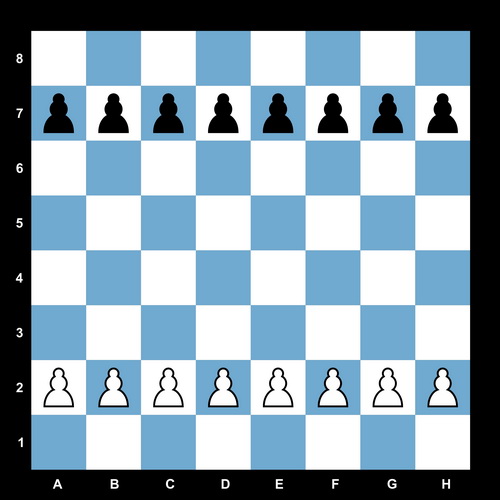
Unlike in Fischer Random Chess, only three pieces (two Bishops and one Rook) are placed randomly and asymmetrically on the players' back ranks, meaning that the positions of Black and White are almost always different. The Bishops must be placed on squares of different colors. To generate a random position, adapt any of the Chess960 position generation methods or use an online random number generator.
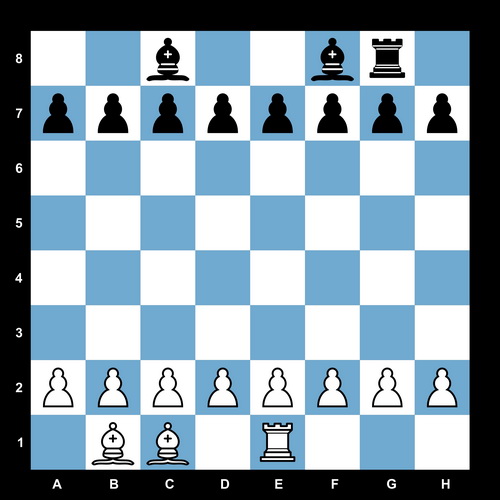
Davor Vujacic writes:
Here is an example of how I used Ingo Althofer’s single die method for Fischer-Benko Chess random starting positions of two Bishops and one Rook. For first bishop and that is the white bishop at white square, there are 4 possible positions. Using single die, I got number 1 and placed bishop at b1 (first white square). I repeated the process for black bishop at white square, got number 2 and placed bishop at c8 (second white square ). I repeated the process with remaining Bishops and got their positions at c1 and f8. After placing bishops there were 6 available squares for Rooks on both sides, so I had to cast die two more times for each of them. For the white Rook I got number 3 and placed white Rook at third free square, at e1. For the black Rook, I got number 5 and placed Rook at fifth free square, at g8.
After both players placed their Bishops and Rook at random positions, the rest of the pieces are placed manually. Just like in Pal Benko’s Pre-Chess, White places one of the remaining pieces (remaining Rook, two Knights, King and Queen) on the first rank, and then Black does the same. The players freely decide in which order they are going to place their remaining pieces.
In the below diagram, we can see that White decided to place his second Rook at its ‘natural’ position at h1. I borrowed notation system from Crazyhouse chess variant so we can write this move like R@h1. The Black answered with Knight at e8 (N@e8) preparing to fight for the control of the center of chessboard.
1. R@h1 N@e8
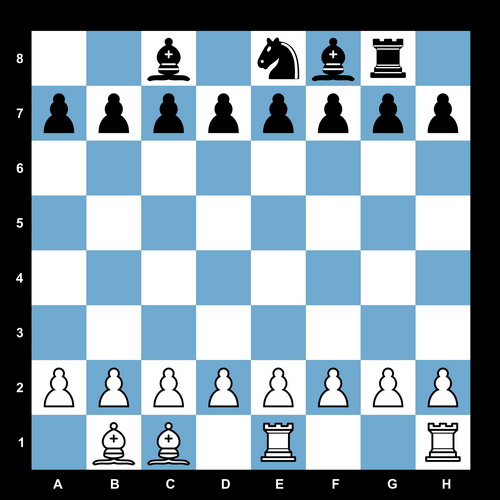
After this, White placed his first Knight at d1 as a response to Black’s previous move and now Black placed the second Rook to a familiar place, at a8.
2. N@d1 R@a8
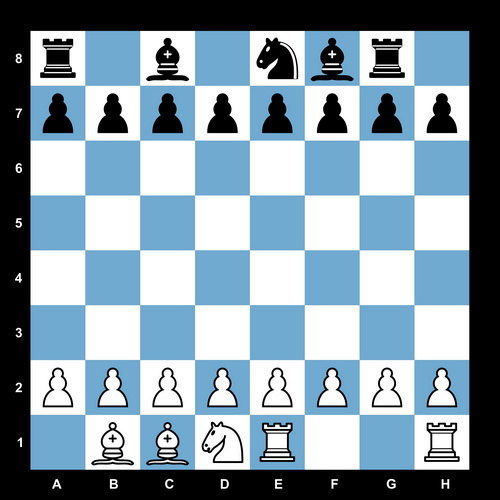
White and Black continue to place their remaining pieces until all of them are placed on their back ranks. The only restriction is that, exactly like in Fischer Random Chess, the King must be placed between the Rooks. The last two pieces are placed simultaneously at their desired positions.
Here we can see that White placed the second Knight at a1, and Black at h8.
3. N@a1 N@h8
Finally, both players placed their Queens and Kings (their last pieces in this case) in double moves. As the order in which players placer their pieces manually is not important, their last pieces could have been different, not necessarely the Queens and Kings, but it is logical to presume that the players would choose to place their most important pieces for the attack and defense, the Queen and the King at the end.
4. Q@g1+K@f1 Q@b8+K@d8
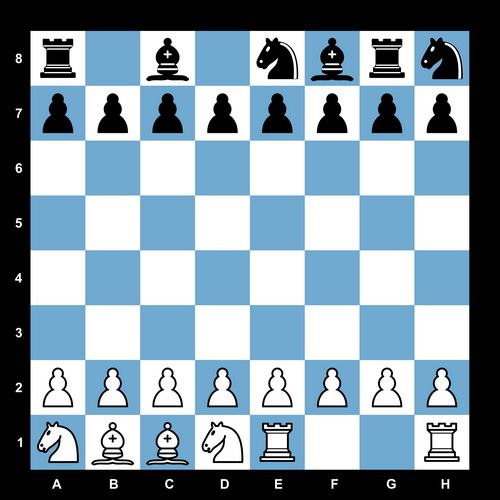
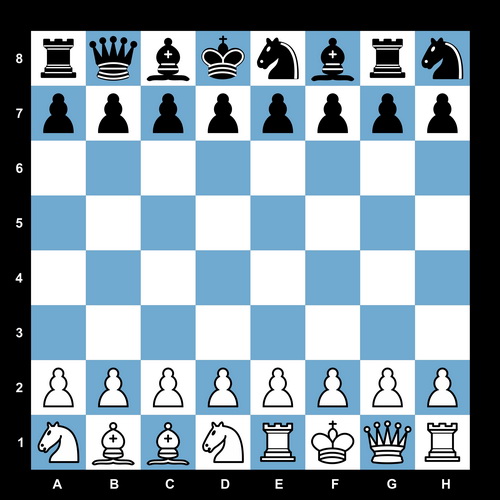
Rules
After all the pieces are on the board, the game proceeds in the usual way, according to the rules of Fischer Random Chess, including there the castling rules of that game.
In real life and real battles, symmetry is very rare. Also, there are always some unpredictable circumstances that are in this game, presented as randomness. Luckily, we also have free will, and ability to analyze the situation and to adapt ourselves to it, in order to survive and win. That’s the whole meaning of this game.
Notes
Davor Vujacic later developed Half-Random Transcendental Chess, or Benko-Lawrence Chess, together with Ola Sassersson who is co-author of this variant of chess. As the name implies, it uses Transcendental Chess as a base rather than Fischer Random Chess. The rules are as above, with two differences:
- The King does not have to be placed between the Rooks and therefore there are 8,294,400 possible starting positions!
- There is no castling.
- Unlike in original Transcendental Chess, only one game is sufficient to determine winner and there is no need to additionally equalize chances of players to win.
Sample games
Davor Vujacic (Daslov) and Srecko Lukic (Wingedlion1), friends since early childhood, but now living in two different countries, played several games of Fischer-Benko Chess and Half-Random Transcendental Chess online at Lichess.org - From Position games. For random setup of bishops and rook, they used random generator number. After that, they used Viber to communicate the position of other pieces. Here are two examples.
Half-Random Transcendental Chess sample game
Srecko Lukic (White) – Davor Vujacic (Black) July 11, 2020

Random setup of bishops and rooks.
Setup phase:
- R@e1 N@f8
- N@h1 N@c8
- N@c1 R@h8
- Q@b1 Q@g8
- K@g1 K@b8

- Ng3 e5
- b3 d6
- c4 b6
- a4 Bb7
- a5 Nd7
- d4 c5
- dxc5 Nxc5
- b4 Ne6
- Ne4 Bxe4
- Qxe4 Re7
- axb6 Bxb6
- Nb3 Qd8
- Na5 Bxa5
- bxa5 Qxa5
- Rb1+ Nb6
- g3 Nc5
- Qc6 Rd7
- Bg2 Nb7
- Red1 Rc8
- Qe4 g6
- f4 f5
- Qd3 e4
- Qd4 Qc5
- Qxc5 Rxc5
- e3 Rxc4
- Bf1 Rc2
- Bd4 Kc7
- Bb5 Rd8
- Bf6 Rf8
- Bd4 Nc5
- Ra1 Ra8
- Rdc1 Rxc1+
- Rxc1 a6
- Be2 Kc6
- Kf1 Kd5
- Bd1 a5
- Bc2 a4
- Bb1 Rb8
- Ba2+ Nb3
- Rd1 Kc6
- h3 d5
- g4 Nc4
- Kg2 Nxd4
- Bxc4 dxc4
- Rxd4 Rb2+
- Kf1 a3
- Rxc4+ Kb5
- Rc8 Ka4
- Ke1 a2
- Ra8+ Kb3
- Rb8+ Kc3
- Rc8+ Kd3
- Rd8+ Kxe3

0-1
White resigned, Black is victorious
Fischer-Benko Chess sample game
Davor Vujacic (White) – Srecko Lukic (Black) July 25, 2020

Random setup of bishops and rooks.
Setup phase:
- R@g1 R@a8
- Q@a1 N@h8
- N@b1 Q@g8
- K@d1 K@d8
- N@f1 N@e8

- c4 f5
- e3 a6
- d3 Ba7
- Nc3 Nf6
- Ng3 d5
- b3 d4
- exd4 Bxd4
- Nge2 Ba7
- d4 Qf7
- Bd2 Qh5
- O-O-O Qxh2
- Bf4 Qh5
- Qb2 Ne4
- g4 Qg6
- gxf5 Qxf5
- Bxe4 Qa5
- Nd5 Bb8
- Rxg7 Be6
- Nxe7 Nf7
- d5 Bd7
- Qf6 Qa3+
- Kb1 Qxe7
- Qxe7+ Kxe7
- d6+ cxd6
- Bxh7 Rh8
- Bg6 Be6
- Nd4 Ba7
- Nxe6 Kxe6
- Bxf7+ Kf6
- Rg6+ Kxf7
- Rgxd6 Bxf2
- Rd7+ Kf6
- Rxb7 Rad8
- Rbd7 Rxd7
- Rxd7 Kf5
- Bc7 Ke4
- Rd5 Bd4
- Kc2 Rg8
- b4 Rg2+
- Kb3 Rb2+
- Ka3 Rc2
- Rh5 Rxc4
- Rh4+ Kd3
- Rh3+ Kc2
- Bd6 Kd1
- Rb3 Kc1
- Ka4 Rc2
- a3 Rf2
- Ka5 Kc2
- Rg3 Kb2
- Kxa6 Rf6
- Rg2+ Kxa3
- b5+ Rxd6+
- Kb7 Rb6+
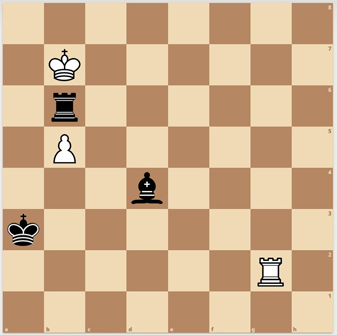
0-1
White resigned, Black is victorious
Final words:
As the inventor of this chess variant, which I named Fischer-Benko-Chess (or Half-Random Chess, if you like it better) and its sub-variant Half-Random Transcendental Chess, which I created together with Ola Sassersson, I always had in my mind that I must remain humble and in deep respect for the giants of Chess, Fischer and Benko, who have left an indelible trace in chess history.
I did not invent the randomness in starting positions that already existed in the Transcendental Chess and in the Fischer Random Chess, nor did I invent the manual placement of chess pieces at their starting position as it already existed in Pal Benko's Pre-chess. I just proposed a new variant that could be used for fun and maybe as a training method, and I tested it with my friends and some family members.
My favorite chess variants are Fischer Random Chess, Transcendental Chess and Pal Benko’s Pre-Chess. The huge number of starting positions was something I liked in Transcendental Chess, but I didn’t like the fact that many of those positions are unfair and strongly favor one or another player. I liked Pre-Chess but when I played it with my friends, it wasn’t random enough, we were just trying to place as many pieces as we could to their natural positions (those from standard Chess). Finally, I liked everything in Fischer Random Chess but I wondered if we could play even more positions that just 960.
And that is how I created this little Frankenstein’s monster among chess variants, assembling rules from my favorite chess variants. This variant belongs to Maxwell Lawrence (Transcendental Chess), Pal Benko (Pre-Chess) and Bobby Fischer (Fischer Random Chess) more than it belongs to me. I hope they would forgive me for playing with their variants of chess and making a compromise in order to create playable and fun chess variants. I hope people would like it and play it as such because it belongs to all of us now. Have a fun!
 This 'user submitted' page is a collaboration between the posting user and the Chess Variant Pages. Registered contributors to the Chess Variant Pages have the ability to post their own works, subject to review and editing by the Chess Variant Pages Editorial Staff.
This 'user submitted' page is a collaboration between the posting user and the Chess Variant Pages. Registered contributors to the Chess Variant Pages have the ability to post their own works, subject to review and editing by the Chess Variant Pages Editorial Staff.
By Davor Vujacic.
Last revised by Davor Vujacic.
Web page created: 2020-05-25. Web page last updated: 2020-05-26
